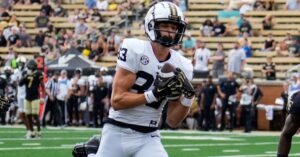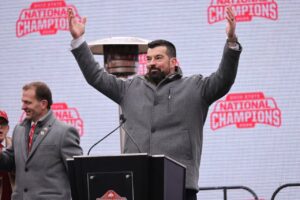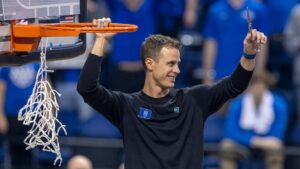
Patrick Peterson considers his amazing career and his time with the Cardinals.
Patrick Peterson, one of the most respected cornerbacks in the NFL, has had a career that not only defines excellence but also stands as a testament to longevity, adaptability, and a love for the game. While Peterson’s journey in the NFL includes playing for multiple teams, his legacy is most strongly tied to the Arizona Cardinals, the team he spent the first decade of his career with. His story with the Cardinals is not just a series of highlights and accolades, but a narrative woven with leadership, resilience, and contributions to a franchise’s most defining moments in the modern era.
Early Beginnings and Entry into the NFL
Patrick Peterson’s career began long before he put on the Arizona Cardinals’ red and white jersey. Born on July 11, 1990, in Fort Lauderdale, Florida, Peterson’s athletic ability was evident from a young age. At Blanche Ely High School, he excelled in both football and track, earning a reputation as a fast, physical athlete. His natural talents made him a standout, and as a result, he was considered one of the top cornerback prospects in the nation.
Peterson decided to stay close to home for college, committing to play for the LSU Tigers. His career at LSU cemented his status as one of the top cornerbacks in college football. As a freshman, Peterson made an immediate impact, helping LSU to an SEC Championship. By the time his junior season rolled around, Peterson had solidified himself as a top NFL prospect. His size (6’1″, 219 lbs), speed, ball skills, and ability to shut down top receivers made him a coveted player in the 2011 NFL Draft.
Draft and Early Days with the Arizona Cardinals
In 2011, Peterson’s dream became reality when he was selected fifth overall in the first round of the NFL Draft by the Arizona Cardinals. Coming into the league, he was already recognized as a future star. The Cardinals were a team on the rise, looking to build on their success from a few years prior when they made a Super Bowl appearance in 2008, but they needed a cornerstone defensive player to continue their climb.
Peterson did not disappoint.
In his rookie season, Peterson quickly made an immediate impact. He was not just a lockdown cornerback, but also a dynamic return specialist. He made a statement on special teams, returning four punts for touchdowns, which was a rookie record at the time. His performance was nothing short of spectacular and earned him the NFL Defensive Rookie of the Year Award. This early success was just a preview of the elite player Peterson would continue to be over the next decade.
But it was on the defensive side of the ball where Peterson truly made his name. Paired with future Hall of Famer Larry Fitzgerald and coached by veteran defensive coordinators, Peterson was able to contribute immediately to the Cardinals’ defense. His versatility in the secondary was apparent, as he was tasked with covering a wide range of elite wide receivers. He proved to be the shutdown corner the team desperately needed, earning respect from his peers and coaches alike.
The Cardinal Years: 2011-2020
From 2011 to 2020, Peterson’s career in Arizona became the foundation upon which the Cardinals built their defensive identity. He was the team’s unquestioned leader, one of the league’s best cornerbacks, and consistently one of the most feared players in the NFL. During this period, Peterson was selected to eight Pro Bowls (2011–2017, 2019, 2020) and named to multiple All-Pro teams. His play on the field was characterized by incredible ball skills, a relentless work ethic, and the ability to shut down some of the best wide receivers in the NFL.
One of the defining aspects of Peterson’s game was his ability to match up against a variety of wide receivers, from the tall and physical to the quick and nimble. Whether it was covering the speed of the Green Bay Packers’ Randall Cobb, the size of the Detroit Lions’ Calvin Johnson, or the technical prowess of the San Francisco 49ers’ Michael Crabtree, Peterson was able to rise to the occasion and excel.
But it wasn’t just Peterson’s physical skills that set him apart; his intelligence and football IQ were equally as impressive. Peterson’s ability to read the quarterback’s eyes and anticipate routes allowed him to make key plays at critical moments. His long reach and ability to high-point the football were also among his standout traits. Through his leadership, the Cardinals’ defense was often one of the league’s best during his tenure.
Throughout his time in Arizona, Peterson faced a series of team transitions. From changes in the head coach position (Ken Whisenhunt, Bruce Arians, and Steve Wilks), to shifts in the front office, Peterson remained a steady force for the franchise. Even as the team’s performance fluctuated, Peterson was a constant, a player who could be relied upon week after week.
In 2013, Peterson helped lead a Cardinals defense that finished among the league’s best in terms of yards allowed and points per game. Although the team didn’t reach the playoffs that year, Peterson’s play served as the bright spot on a defense that was among the NFL’s most feared. In particular, his ability to shadow opposing top receivers was central to the Cardinals’ defensive success.
Decline and the Move to Minnesota
As the years passed, the NFL began to see the emergence of new offensive juggernauts, and the Cardinals struggled to maintain their elite status. Despite the ups and downs of team performance, Peterson’s individual play remained at a high level, even if the team was unable to sustain a playoff push after the 2015 season. Still, Peterson was a key part of the team’s identity and continued to be one of the NFL’s premier cornerbacks well into his 30s.
In 2021, after ten seasons with the Cardinals, Peterson signed a one-year contract with the Minnesota Vikings, bringing his incredible career in Arizona to a close. This move marked the end of an era for the Cardinals, as Peterson had been their cornerstone defensive player for a decade. The decision to leave Arizona was a bittersweet one for both Peterson and the franchise. Peterson had given everything to the Cardinals, and the franchise had helped develop him into one of the NFL’s elite cornerbacks.
While in Minnesota, Peterson continued to play at a high level, contributing his vast experience to a new defense. His transition to the Vikings was seamless, and he remained an integral part of their defense for several years. Even as he moved into the twilight of his career, Peterson remained a key piece of Minnesota’s plans.
Legacy and Impact
Patrick Peterson’s legacy is secure. Over his 12-year career in the NFL, he left an indelible mark on the Arizona Cardinals and the league as a whole. His numerous accolades, including Pro Bowl selections, All-Pro honors, and an NFL Defensive Rookie of the Year Award, speak to his excellence on the field. But it is his leadership, his unwavering commitment to his team, and his ability to evolve his game that will forever define his legacy.
For the Arizona Cardinals, Peterson was more than just a player — he was a symbol of what the team could be at its best. His impact on the team went far beyond his play on the field. Peterson was a mentor to younger players and a vocal leader in the locker room. His professionalism and approach to the game served as a model for those who came after him.
While the Cardinals did not achieve the ultimate goal of winning a Super Bowl during Peterson’s tenure, his contributions helped elevate the team to a level of competitiveness it hadn’t seen in years. Peterson helped lead the team to multiple playoff appearances and was one of the main reasons they were regularly among the top defenses in the NFL. His ability to neutralize the opposing team’s best weapons was invaluable.
Though his time with the Cardinals ultimately came to an end, Peterson’s contributions remain part of the franchise’s history. His legacy in Arizona is one of excellence, resilience, and leadership, and he will always be remembered as one of the greatest players to ever wear a Cardinals uniform.
As Peterson moves into retirement, his legacy will not be forgotten. For young cornerbacks entering the league, Peterson’s career serves as a blueprint for success. His combination of speed, size, ball skills, and intelligence made him one of the best to ever do it. His impact on the Cardinals, the NFL, and the cornerback position will continue to be felt for years to come.





